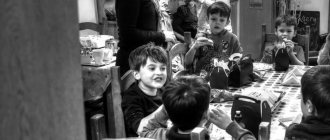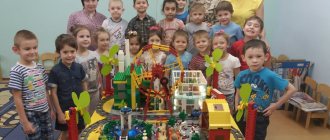Communication as a condition for meeting the needs of a preschooler
Before a child develops the need to communicate with others, he reaches out to others for the sake of comfortable sensations, for the sake of gaining security, for the sake of receiving impressions. These needs appear from the first days of life.
By the age of 3, cognitive needs come to the fore. Where can she be satisfied if not by turning to an adult?
Kids need to make so many discoveries and understand how this world works that they constantly need explanations and help from parents, educators, and older brothers and sisters.
Younger preschoolers not only ask questions. They strive to express their Self. They need to address it to someone: “I myself!” Or draw the attention of the same children to yourself, saying “These are my toys”, “Look what doll they gave me.” For such self-affirmation, viewers, listeners, and partners are needed. Communication provides them.
By the age of five, the need for respect is formed. Children demonstrate what they have already learned and what they know or can do. When communicating with peers, edifying phrases are often heard: “Look how you should do it,” “Do it as I do!” In addition, in middle preschool age, boys and girls need equal play partners. Children's games are nothing more than an organized form of communication.
For older preschoolers, the need to talk about their impressions, convey interesting information and establish their authority among their peers is becoming more urgent. Therefore, their communications cover an increasingly larger circle of peers. Preschoolers are already good at identifying moral qualities, so they are drawn to those peers who are closer to them.
We have provided a small list of needs that preschoolers satisfy in communicating with others.
Communications that arise on the basis of certain needs, motives, as well as the verbal and non-verbal means used, form stable forms of communication.
For children, almost all interactions are tied to specific situations. With growing up, forms of communication in preschoolers develop, and they acquire an extra-situational character.
Conditions for the formation of communication
Let us briefly consider the pedagogical conditions necessary for the formation of communicative competence in older preschoolers.
These conditions are: social component (the child feels the need to communicate with both adults and peers); participation in collective creativity; playing with a group of other children, training in a playful way.
Social situation in communication
The social situation is the relationship that a child has with the world around him. These relationships are quite specific and have a number of features characteristic only of children.
The child’s lifestyle and his interaction with society depend on the social situation. As a result of this, in the process of various types of activities, new personal properties of the child appear and new mental formations are formed.
The age of older preschoolers is characterized by the following features of the development of the social situation:
- Relationships with adults are changing. If previously they took an extra-situational cognitive form, now these relationships are developing into an extra-situational personal form.
- The child becomes capable of being systematically taught.
- Relationships with peers undergo transformation.
- The child becomes aware of his own “I”.
- The personality of a preschooler acquires visible features.
- Verbal means are increasingly used for communication.
It turns out that a social situation is a whole system of relationships between a child and the social reality within which he lives, which he realizes in the process of joint activities with people of different ages.
Social situation in communication with peers and adults
The preschool period activates the social situation through frequent contacts with peers and adults.
When communicating with adults, children show significant independence. This allows them to expand their knowledge of the world around them. Children use language to communicate to expand their knowledge.
They tend to ask a lot of questions. Questions "why?" and for what?" most often heard in the families of such children. Curiosity is an innate human quality that manifests itself most clearly during the preschool period of development.
Communication as a social activity and cognitive activity
Although most often during cognitive activity the child plays the role of a listener, he feels the need for adults to treat him as a partner or comrade. Cooperation “as equals” in such situations activates the cognitive processes of a preschooler.
In addition to cognitive communication, preschoolers begin to feel the need for another form of communication - personal. The personal form of communication is characterized by the fact that the child begins to discuss with his parents how other people act and behave.
A social situation is a whole system of relationships between a child and the social reality around him, which he realizes in the process of joint activities with adults and peers.
There is a certain contradiction in the existing social situation. A child often wants to be like adults, but at the same time does not have the opportunity to realize this need.
Communication in gaming activities
In order for the process of developing communicative competence to be effective, it is important to consider what activities are leading for a given age stage. In the preschool period, of course, the leading activity is play.
Play can change the relationship between adults and children. These relationships become closer. They have a common cause, which contributes to the establishment of strong relationships and mutual understanding. In subsequent periods of child growth, this will be much more difficult.
In order to eliminate the existing contradiction, you need to play role-playing games. In such a game, the child plays the role of an adult who has certain social functions, due to which he enters into interactions with “real” adults.
Role play and communication as a social activity
Thanks to role-playing play, a preschooler can feel like a participant in such social activities that are not available to him in everyday life.
Researchers who study the play activity of preschoolers are unanimous in the opinion that children somehow always manage to find an opportunity to resolve the existing contradiction in the social situation, which is why children experience joy and satisfaction, which makes them return to play activities again and again.
Thanks to games, children begin to understand the essence of certain problems. By solving them together with adults during play, children try out social norms and roles that do not yet correspond to their status.
During play activities, children gain the opportunity to experience new impressions, gain social experience, and can communicate with other children in a different way than they do in everyday life.
After the game has been organized and carried out, the children are given the opportunity to conduct a joint analysis of the game and discuss the experiences they have gained.
Role-playing games are the most effective for developing communication skills.
Communication as a social activity and leading gaming activity
Preschool age is characterized by the fact that gaming activity is the leading one for a person, which gives him the opportunity to develop and learn to interact correctly with the world around him and other people.
During play, a child has the opportunity to reproduce various meanings of human activity and learn those forms of relationships that he will use throughout his life.
Researchers who study the play activity of preschoolers are unanimous in the opinion that children somehow always manage to find an opportunity to resolve the existing contradiction in the social situation, which is why children experience joy and satisfaction, which makes them return to play activities again and again.
Communication as a social activity and joint games
Joint play activities are an opportunity to gain new experiences; children communicate with other children in a way they do not do in everyday life. After the game has been played, you need to analyze it together and share the experience gained.
Working with children within the kindergarten, teachers create a special communicative and play environment that has a beneficial effect on the personality of preschoolers.
This environment is a whole play space, which is designed so that children are forced to communicate with each other. The first step is to teach children how to properly use play environment materials.
Next, children are taught various joint actions, which helps to activate communication processes between peers.
Children have the opportunity to do something in front of their peers.
Such contact leads to inevitable interactions, as situations arise when several children do the same action. If at the same time we organize closer physical contact, this will help children begin to talk to each other and coordinate their intentions and actions.
Communication as a social activity and creative collective activities
In order for the development of communicative competence to be successful, it is necessary to organize various creative collective activities.
Teamwork can take many different forms:
- joint production of panels;
- poster development;
- crafts for play;
- illustrating an interesting fairy tale;
- exhibition design;
- creation of costumes or scenery.
In order to choose a suitable form of cooperation, you need to take into account the age of preschoolers, the number of people attending the group, and how long the lesson will be organized.
The complexity and content of the classes should be selected based on the age of the children. Collective work should be carried out both in the morning and in the evening, and during daytime classes organized by teachers.
Any joint work organized by educators must have its own goal. The teacher organizes the lesson in such a way as to convince the children that any complex problem can be solved much faster and easier when people act together.
By collaborating with adults and with each other, children learn to communicate. At first, children communicate only with teachers in the process of collective work. However, over time, this communication as a social activity spills over into communication with peers.
Gradually, children reach a level of communication development at which they can already plan activities together, negotiate, ask each other questions, give tips and empathize with each other. The teacher should teach preschoolers to give in to each other and be grateful for the help of their comrades.
The easiest way to organize joint work is to sculpt from plasticine or appliqué. Drawing is more difficult to collectivize. The form in which the lesson will be organized should take into account the age of the children and their communication skills.
For preschoolers to work together in drawing, teachers select topics related to folk art motifs. There are different ways to organize this activity. For example, you can assign each child to draw a pattern on one strip or square.
When all the children have finished, the individual parts are connected and a decorative composition is formed, which is laid out on a large white sheet of paper.
Communication during trainings
Children really enjoy the classes conducted in the form of trainings. In these classes, children team up in groups of two to create a common composition. This develops in children the ability for business communication and cooperation. It also helps you learn to negotiate with your partner. And then communication as a social activity is formed more effectively.
Group training is effective for developing communication skills. Preschoolers are taught to use their own regulatory means to coordinate communicative actions. It also contributes to the assimilation of the cultural characteristics of the country.
Children practice observing the actions of other people and thinking about various communication situations. In order to help a child use his full communicative potential, you need to use all available means.
How do preschoolers communicate with others?
If we briefly consider how forms of communication progress in preschool age, then it is best to turn to the work of the famous psychologist M.I. Lisina, who identified four levels of communication from infancy to 7 years, designating them as a form:
- Situational-personal
- Situational business
- Extra-situational-cognitive
- Extra-situational-personal
The first ones in this list are formed earlier, based on specific actions, objects, and experiences. By older preschool age, they do not disappear, but partially give way to more developed forms that are not tied to the situation. These changes are facilitated by the development of children's speech and verbal-logical thinking.
The highest form of communication for preschool age is one that promotes understanding of the meaning of human relationships, as well as the assimilation of the norms and values of society. Consequently, this is an extra-situational-personal form of communication.
Possible causes of communication problems in a preschooler
There are several personality traits that can be perceived negatively by others and create problems in interpersonal communication.
- Aggressiveness. Preschoolers usually avoid children who might hit them or who constantly take their toys away from them.
- Shyness. Excessive timidity, indecisiveness, and modesty prevent a child from making friends and feeling confident in a group of children.
- Selfishness. If a child is guided only by his own interests and does not take into account the opinions of his peers, children may lose interest in communicating with him.
- Passivity. Preschool children like to play and communicate with those who take the initiative and are able to captivate them.
Talk to your child more often about his friends, whether he feels comfortable among his peers, ask what they do together, what they play. If you find any problem in communication, then you should not leave everything to chance. The child needs your support.
Forms of communication between preschoolers and peers
In the period from 3 to 7 years, forms of communication with peers are observed, which are consistently updated from younger to older preschool age:
- Emotional-practical
- Situational business
- Non-situational business
Communication among younger preschoolers is stimulated by emotions or practical action. Kids can simply run up to each other with a joyful smile, and this is already a sign that they are interested in communicating. It is not so important how long their communication will captivate them. The emotionality of contact is valuable.
The children's joint actions are still short-lived. They can make Easter cakes nearby or roll cars. They can demonstrate how far they throw a ball or slide down a slide. However, the emotional-practical form of communication provides the basis for the formation of initiative in communication.
In middle preschool age, children's business communication actively develops. This is due to the fact that the role-playing game progresses story-wise. Preschoolers no longer play just side by side, but together, choosing more complex plots, distributing roles, and agreeing on the rules.
Some business qualities are demonstrated, but they are tied to situations. For example, a child may act as a strict controller in the game in accordance with the chosen role, but behave timidly in ordinary contacts.
Extra-situational relationships allow you to shift attention from the actions of the communication partner to the person himself. Unexpectedly, the preschooler begins to see his play partner as an interlocutor, a person with his own interests and preferences. Another thing is that the revealed personality traits can either please or repel. Both a boy and a girl can tell their yesterday’s friend that they no longer play with him, because he takes other people’s toys without permission, offends others, etc.
Among children, a preschooler acquires behavioral skills, learns mutual understanding, and discovers social values.
The behavior of peers serves as a kind of mirror, allowing the child to see himself from the outside. And developing social intelligence helps the preschooler to notice the nuances of facial expressions and statements that previously escaped attention.
Conditions for developing communication skills
Now let’s summarize the conditions necessary for the effective development of communication skills in older preschoolers:
- Interaction between children and adults. This allows the child to adopt existing social norms from adults. Often children are faced with the need to adjust their own behavior in accordance with the norms and requirements accepted in society;
- Regular interaction with peers. Thanks to this, children not only learn to understand the surrounding reality, but children are also given the opportunity to communicate with peers and learn to build friendly relationships with both girls and boys. Preschoolers usually take an active interest in other children, and this is an innate need to interact with peers;
- It is important to properly organize activities that teach children to communicate. In such classes, children’s speech abilities are activated, their personal and emotional characteristics are revealed in full force. This is how children acquire communication skills, learn to make friends and competently resolve conflict situations.
Social skills can be fully developed only if the child gains experience in communicating with other children. Moreover, this should happen under the control of teachers and under their competent leadership. Children must gain experience in social interaction.
We believe that a set of skills alone cannot ensure adequate communicative behavior. It is important to consider this phenomenon more broadly. Children must be able to see the connection between the knowledge they have and the situation in which they find themselves. Children must learn to detect in time one or another communication skill that is most suitable for the problem at hand.
Thus, important conditions are: the social situation of the child’s development (the need to communicate with adults and peers); organization of collective creative activities; joint play activities and training (based on play activities), which create the child’s zone of proximal development.
Forms of communication between children and adults
Communication with adults is, in essence, interactions in the “zone of proximal development,” since a preschooler uses his potential and fills in the blank spots in his knowledge.
Starting from the age of 3, the baby becomes an active explorer of everything around him.
The need for cognitive activity and the desire to get answers to puzzling questions directs him to his parents or other significant adults. Interaction takes on an extra-situational character and is realized in two forms of communication that follow each other.
Extra-situational-cognitive communicative form
Communication can be situational in nature, and the child may ask to draw the same bunny that he has in his hands. But increasingly, interest goes beyond situations. The preschooler asks where the bunny lives, if he has a house, and immediately continues to ask questions about all the animals he knows.
An adult is an expert for a child who knows everything and can do everything. The kid accepts any answer. Often these answers are presented in a fantasy or fairy tale context. And how else can a child answer the question in style, does the Bear sing songs to her Little Bear?.. Nevertheless, the preschooler satisfies his current cognitive interest.
Cognitive communication with an adult gives the child real ideas about the world and expands his understanding of the cause-and-effect relationships between surrounding objects and phenomena.
Extra-situational-personal form of communication
The older a preschooler gets, the more he understands that the social environment is much wider and more diverse than his usual environment. The child realizes that he needs to learn how to behave and act correctly in different situations. Moreover, he sees the different behavior of his peers, which leads him to the conclusion that not everyone behaves as they should.
The preschooler has questions for elders in order to understand the meaning of relationships between people. To some extent, the older preschooler checks his point of view to see whether it coincides with the position of the adult. This is how generally accepted social norms are assigned.
By talking with adults, the child learns standards of expression and behavioral cultural norms. The preschooler begins to develop his own authorities. To understand a certain situation, he increasingly turns to the adult whom he considers most competent in this matter.
Topic: Development of communication among children in preschool age
Plan:
1. Forms of communication between preschoolers and peers.
2. Psychological and pedagogical conditions for organizing communication between children in preschool age.
3. Features of children’s communication with peers in preschool age.
4. Motives for communication between preschoolers and peers (business, personal, cognitive).
Extra-situational communication between a preschooler and an adult
The emergence and development of speech makes possible the next stage in the development of communication between a child and an adult, which differs significantly from the previous two (situational-personal and situational-business communication). The first two forms of communication were situational, because their main content was directly present in a specific situation. Both the good attitude of an adult, expressed in his smile and affectionate gestures (situational-personal communication), and objects in the hands of an adult that can be seen, touched, examined (situational-business communication), were next to the child, before his eyes.
The content of the following forms of communication is no longer limited to the visual situation, but goes beyond it. The subject of communication between a child and an adult can be such phenomena and events that cannot be seen in a specific interaction situation. For example, a child and an adult can talk about the rain that has already passed, that the sun is shining, about birds that have flown to distant countries, about the design of a car, etc. The content of communication can also be their own experiences, goals and plans, relationships, memories. All this also cannot be seen with the eyes and touched with the hands, however, through communication with an adult, all this becomes quite real and meaningful for the child. It is obvious that the emergence of non-situational communication significantly expands the horizons of the life world of a preschooler.
Extra-situational communication becomes possible only due to the fact that the child masters active speech. After all, speech is the only and universal means that allows a person to create stable images and ideas about objects that are not currently in front of his eyes, and to act with these images and ideas that do not exist in a given interaction situation. Such communication, the content of which goes beyond the perceived situation, is called extra-situational.
.
Extra-situational communication can only take place in verbal form, like a conversation between a child and an adult. Such communication places new demands on the behavior of an adult. It is no longer enough just to be attentive to the child and play toys with him. It is imperative to talk, talk about what the preschooler himself does not yet know, has not seen, and expand his ideas about the world.
There are two forms of extra-situational communication - cognitive and personal
.
Extra-situational-cognitive communication
In the normal course of development, extra-situational-cognitive
Communication develops around four to five years of age. A clear evidence of the emergence of such communication in a child is his questions addressed to an adult. These questions are mainly aimed at clarifying the patterns of living and inanimate nature. Children of this age are interested in everything: why squirrels run away from people, where butterflies spend the winter, what paper is made from, etc. Only an adult can give answers to all these questions. An adult becomes for preschoolers the main source of new knowledge about events, objects and phenomena occurring around them.
It is interesting that children of this age are satisfied with any answer from an adult. It is not at all necessary for them to give scientific justification for the questions that interest them, and this is impossible to do, since children will not understand everything. It is enough to simply connect the phenomenon that interests the child with what he already knows and understands. For example: butterflies overwinter under the snow, they are warmer there; squirrels are afraid of hunters; paper is made from wood, etc. Such very superficial answers completely satisfy preschoolers and contribute to the fact that they develop their own, albeit still primitive, picture of the world.
At the same time, children's ideas about the world remain in human memory for a long time. Therefore, an adult’s answers should not distort reality and allow all the explanatory magical forces into the child’s consciousness. Despite their simplicity and accessibility, these answers should reflect the real state of affairs. The main thing is that the adult answers the children’s questions so that their interests do not go unnoticed. The fact is that in preschool age a new need develops - the need for respect from an adult. Simple attention and cooperation with an adult is no longer enough for a child. He needs a serious, respectful attitude towards his questions, interests and actions. The need for respect and recognition becomes the main need that encourages the child to communicate. In the behavior of children, this is expressed in the fact that they begin to be offended when an adult negatively evaluates their actions, scolds them, and often makes comments. If children under three or four years of age, as a rule, do not respond to an adult’s comments, then at an older age they are already waiting for the teacher’s assessment. It is important for them that the teacher not only notices, but also praises their actions and answers their questions. If an adult makes comments too often, constantly emphasizes the child’s inability or inability to do some activity, the latter loses all interest in this matter.
The best way to teach a preschooler something, to instill in him an interest in some activity, is to encourage his success and praise. For example, what to do if a five-year-old child cannot draw at all? Of course, you can objectively assess his capabilities, constantly make comments to him, comparing his bad drawings with the good drawings of other children and encouraging him to learn to draw. But this will make him lose all interest in drawing, he will refuse an activity that causes continuous criticism from the teacher. And, of course, in this way he will not only not learn to draw better, but will avoid this activity. Or, on the contrary, you can form and maintain the child’s faith in his abilities by praising his most insignificant successes. Even if the drawing is far from perfect, it is better to emphasize its minimal (even non-existent) advantages than to give a negative assessment. Encouraging an adult not only instills in the child confidence in his abilities, but also makes the activity for which he was praised important and loved. The child, trying to maintain and strengthen the positive attitude and respect of the adult, will try to draw better and more. And this, of course, will bring more benefits than fear of comments and awareness of one’s inability.
So, cognitive communication between a child and an adult is characterized by:
1) good command of speech, which allows you to talk with an adult about things that are not in a specific situation;
2) cognitive motives of communication, curiosity, the desire to explain the world, which is manifested in children’s questions;
3) the need for respect from an adult, which is expressed in resentment at comments and negative evaluations.
Extra-situational-personal communication
Over time, the attention of preschoolers is increasingly attracted to events occurring among the people around them. Human relationships, norms of behavior, and the qualities of individual people begin to interest the child even more than the lives of animals or natural phenomena. What is possible and what is not, who is good and who is evil, what is good and what is bad - these and other similar questions are already worrying older preschoolers. And again, only an adult can give answers here. Of course, even before, the teacher constantly told the children how to behave, what was possible and what was not, but the younger children only obeyed (or did not obey) the adult’s demands. Now, at six or seven years old, children themselves are interested in rules of behavior, human relationships, qualities, and actions. It is important for them to understand the demands of adults and to confirm that they are right. Therefore, in older preschool age, children prefer to talk with adults not about educational topics, but about personal ones that concern people’s lives. This is how the most complex and highest in preschool age arises - non-situational-personal
form of communication.
An adult is still a source of new knowledge for children, and children still need his respect and recognition. But it becomes very important for a child to evaluate certain qualities and actions (both his own and other children) and it is important that his attitude to certain events coincides with the attitude of an adult. The commonality of views and assessments is for the child an indicator of their correctness. It is very important for a child in senior preschool age to be good, to do everything correctly: to behave correctly, to correctly evaluate the actions and qualities of his peers, to build his relationships correctly with adults and with peers.
This desire, of course, must be supported by the teacher. To do this, you need to talk with children more often about their actions and relationships between them, and evaluate their actions. Older preschoolers are no longer more concerned about the assessment of specific skills, but of their moral qualities and personality as a whole. If a child is sure that an adult treats him well and respects his personality, he can calmly, in a business-like manner, treat comments regarding his individual actions or skills. Now a negative assessment of his drawing does not offend the child so much. The main thing is that he is generally good, so that an adult understands and shares his opinions.
The need for mutual understanding is a distinctive feature of the personal form of communication. If an adult often tells a child that he is greedy, lazy, cowardly, this can greatly offend and hurt, but will not lead to the correction of negative character traits. Here again, to maintain the desire to “be good,” it will be much more useful to encourage correct actions and positive qualities than to condemn shortcomings.
In older preschool age, non-situational-personal communication exists independently and represents “pure communication”, not included in any other activity. It is stimulated by personal motives, when another person attracts a child on his own. Thus, this form of communication comes close to the primitive personal (but situational) communication that is observed in infants. However, the personality of an adult appears for a preschooler in a completely different way than for an infant. The senior partner is no longer an abstract source of attention and goodwill for him, but a specific person with certain qualities (marital status, age, profession). All these qualities are very important for a child. For him, an adult is a competent judge who knows “what is good and what is bad” and a role model.
Thus, non-situational-personal communication, which develops towards the end of preschool age, is characterized by:
1) the need for mutual understanding and empathy;
2) personal motives;
3) speech means of communication.
Extra-situational and personal communication is important for the development of a child’s personality. Firstly, he consciously assimilates the norms and rules of behavior and begins to consciously follow them in his actions and actions. Secondly, through personal communication, children learn to see themselves as if from the outside, which is a necessary condition for consciously managing their behavior. Thirdly, in personal communication, children learn to distinguish the roles of different adults - educator, doctor, teacher - and, in accordance with this, build their relationships in communication with them differently.
Form of communication and age of the child
The main forms of communication between children and adults in preschool age during the normal development of the child take shape at a certain age. Thus, the first, situational-personal form of communication appears in the second month of life and remains the only one until six to seven months. In the second half of life, situational business communication with adults is formed, in which the main thing for the child is joint play with objects. This communication remains primary until about 4 years of age. At the age of four to five years, when the child already has good speech and can talk with an adult
on abstract topics, non-situational cognitive communication becomes possible. And at the age of six, i.e., towards the end of preschool age, verbal communication with adults on personal topics arises.
Of course, this is only a general, average age sequence, reflecting the normal course of child development. Deviations from it for minor periods (six months or a year) should not cause concern. However, in real life, quite often one can observe significant deviations from the indicated timing of the emergence of certain forms of communication.
It happens that children remain at the level of situational and business communication until the end of preschool age. Quite often, preschoolers do not develop verbal communication on personal topics at all. And in some cases, in a five-year-old preschooler, situational and personal communication predominates, which is typical for an infant in the first half of the year. Of course, the behavior of a preschooler is not at all similar to that of an infant, but in essence, the attitude towards an adult and communication with him in a large child can be the same as in an infant. For example, a preschooler strives only for physical contact with the teacher, hugs and kisses him, and freezes with bliss when an adult pats him on the head. At the same time, any meaningful conversation or joint game causes embarrassment, isolation and even refusal to communicate. The only thing such a child needs from an adult is attention and kindness.
This type of communication is normal for a baby of two to six months, but if it is the main one for a five-year-old preschooler, this is an alarming symptom that indicates a serious developmental delay. Usually this lag is caused by the fact that the child at an early age did not receive the necessary personal, emotional communication with an adult. This phenomenon, as a rule, is observed in orphanages, and in normal conditions of education it is quite rare.
But being “stuck” at the level of situational business communication until the end of preschool age is more atypical. It lies in the fact that children only want to play with an adult, they only care about what toys the teacher will allow them to take today, what game he will offer them. They play with pleasure with adults, but avoid any conversation on educational and personal topics. This is natural for a child between one and three years old, but such behavior in five to six year old children should cause concern and concern. If, until the age of six, the interests of a preschooler are limited to objective actions and games, and his statements relate only to surrounding objects and momentary desires, we can talk about a clear delay in the development of communication between the child and adults.
At the same time, in some rather rare cases, the development of communication outstrips the child’s age. For example, some children, as early as three or four years old, show interest in personal problems, human relationships, love and can talk about how to behave, and strive to act according to the rule. In such cases, we can talk about extra-situational-personal communication already in early preschool age. However, such advance is also not always favorable. In cases where extra-situational-personal communication occurs immediately after situational-business communication, the period of extra-situational-cognitive communication is missed, which means that the child does not develop cognitive interests and the rudiments of a child’s worldview.
The correct course of development lies in the consistent and full experience of each form of communication at the appropriate age. And each age, as shown above, is characterized by its corresponding form of communication with an adult.
Of course, the presence of a leading form of communication does not mean that all other forms of interaction are excluded and that a child who has achieved, for example, an extra-situational-personal form of communication, does nothing but talk with an adult on personal topics. In real life, a variety of types of communication coexist, which come into play depending on the situation. The ability to communicate (both in a child and an adult) lies precisely in the extent to which a person’s behavior corresponds to the tasks and requirements of the situation, how widely he uses and varies business, cognitive and personal contacts with another person. But the level of communication development is determined by the child’s highest achievements in this area. An indicator of the development of communication is not the predominance of certain contacts, but the opportunity and ability to communicate on different topics - depending on the situation and the partner.
In order to carry out certain pedagogical work with a child in order to develop his communication with adults, you need to be able to identify the highest level of communication of the child, maximum achievements in this area. How can we determine at what level of communication development a child is?
First of all, of course, you need to carefully observe. For what reasons does a child most often turn to an adult? Does it require evaluation of its actions? Does he ask questions? All this can be found out by observing a child in a kindergarten group or on a walk. If you witness the passive, uninitiative behavior of a child, if he spends hours studying with objects without contacting the teacher at all, you should take a closer look at such a child. His behavior, although it may be convenient for the teacher, should cause alarm: most likely, these are symptoms of an underdeveloped (and perhaps even absent) need for communication. If a child, on the contrary, does not leave the teacher, waits for his affection, but at the same time does not know how to play, listen to fairy tales, or talk with an adult, this may indicate a clear delay in the development of communication.
Practical lessons:
1. Determination of the goals and objectives of organizing communication between preschoolers of different age groups according to the preschool education program proposed by the teacher.
Some features of personal communication
The desire to communicate with adults largely depends on the personal expectations of the preschooler. If a child has a predominantly positive experience of previous contacts with specific adults, he is drawn to them. Conversely, negative impressions cancel out the desire to communicate. Some grandmothers wonder why their grandchildren are so reluctant to visit them. They don’t even notice how zealously they protect the inviolability of their shelves, how strictly they reprimand the child when he violates the usual order in their apartment.
Personally, a preschooler needs warm emotional connections and adults to be interested in him, his activities and skills. The child expects support and empathy, he is sensitive to praise. This does not mean that children should be praised. But there will always be achievements worth celebrating.
It is curious, but the following phenomenon is observed: loving parents and grandparents always find a reason to support and praise the child. If there are no warm feelings, the child is often scolded and his mistakes pointed out rather than supported.
Children are attracted to the positive emotional content of relationships with significant adults. This is the favorable background against which cognitive and personal communication is successfully implemented.
How to teach a child to communicate with peers?
To create a basis for the development of sociocommunicative skills for the baby, parents are recommended to adhere to the following principles:
- Be open and sincere in your family. Respectful relationships between family members, mutual assistance, and politeness are a wonderful example for a child. By observing adults, he will learn a lot about how people communicate, and will try to copy this pattern of relationships.
- Talk to your baby more often. The topic of feelings and emotions is very important and relevant for preschoolers.
- Instill respect for others. The child must understand that in addition to his personal interests, there are the opinions and desires of other people. This does not mean that the child should always make concessions (for example, share his toys if he does not want to), because in the future he will definitely have to defend his interests someday, which means he needs to learn this. Explain how you can negotiate and argue your point of view.
- If possible, do not interfere in children's conflicts if at the moment nothing threatens the health of the children and their environment.
- Encourage initiative in communication.
- Do not criticize the child's personality, especially in the presence of strangers.
- Don't show negative feelings towards other children.
- Regularly visit with your child places where his peers are (playgrounds, clubs, full-day or short-term groups, clubs and sections, guests).
A child who has difficulty communicating with peers needs special attention and care. But your help should not be intrusive; you should not do for the baby what he is capable of himself.
The following can help your child understand the complex world of human relationships:
- Role-playing games on the theme of friendship. Games are the most effective way to teach preschool children. Using toys that you have at home, play out simple stories with your baby related to communication processes. For example, Bear meets the Hare and invites him to be friends, the Kitten gets offended by the Puppy because he teases him, and so on. A child, absorbed in the game, will definitely remember the behavior patterns that you show him.
- Books and cartoons about friendship;
- Conversations;
- Personal example of close adults.






